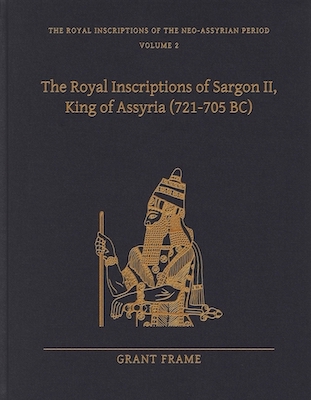You are seeing an unstyled version of this site. If this is because you are using an older web browser, we recommend that you upgrade to a modern, standards-compliant browser such as FireFox [http://www.getfirefox.com/], which is available free of charge for Windows, Mac and Linux.
Sargon II (721-705 BC)

The Neo-Assyrian king Sargon II was one of the most important and famous rulers of ancient Mesopotamia. In this volume of critically important ancient documents, Grant Frame presents reliable, updated editions of Sargon's approximately 130 historical inscriptions, as well as several from his wife, his brother, and other high officials.
Beginning with a thorough introduction to the reign of Sargon II and an overview of the previous scholarship on his inscriptions, this modern scholarly edition contains the entire extant corpus. It presents more than 130 inscriptions, preserved on stone wall slabs from his palace, paving slabs, colossi, steles, prisms, cylinders, bricks, metal, and other objects, along with brief introductions, commentaries, comprehensive bibliographies, accurate transliterations, and elegant English translations of the Akkadian texts. This monumental work is complemented by more than two dozen photographs of the inscribed objects; indices of museum and excavation numbers, selected publications, and proper names; and translations of relevant passages from several other Akkadian texts, including chronicles and king lists.
Informed by advances in the study of the Akkadian language and featuring more than twice as many texts as previous editions of Sargon II's inscriptions, this will be the editio princeps for Assyriologists and students of the Sargonic inscriptions for decades to come.
Further reading
J. Elayi, Sargon II, King of Assyria (Archaeology and Biblical Studies 22). Atlanta, 2017.
G. Frame, The Royal Inscriptions of Sargon II, King of Assyria (721-705 BC) (The Royal Inscriptions of the Neo-Assyrian Period 2). Winona Lake, 2021. [https://www.eisenbrauns.org/books/titles/978-1-64602-109-3.html] BUY THE BOOK. [https://www.eisenbrauns.org/books/titles/978-1-64602-109-3.html]
A. Fuchs, Die Inschriften Sargons II. aus Khorsabad. Göttingen, 1994.
A. Fuchs, "Sargon II," pp. 51-61 in M.P. Streck et al. (eds.), Reallexikon der Assyriologie und Vorderasiatischen Archäologie 12/1-2. Berlin, 2009.
A. Kirk Grayson, "Assyria: Tiglath-pileser III to Sargon II (744-705 B.C.)," pp. 86-102 in J. Boardman et al. (eds.), The Cambridge Ancient History, second edition, vol. 3/2. Cambridge, 1991.
F. Maniori, Le campagne bavilonesi ed orientali de Sargon II d'Assiria: un'analisi topografica. Rome, 2014.
S.C. Melville, The Campaigns of Sargon II, King of Assyria, 721-705 B.C. (Campaigns and Commanders 55). Norman, OK, 2016.
The aim of RINAP 2, a sub-project of Royal Inscriptions of the Neo-Assyrian Period (RINAP) Project [http://oracc.museum.upenn.edu/rinap/index.html] and the Official Inscriptions of the Middle East in Antiquity (OIMEA) Project [http://oracc.museum.upenn.edu/oimea/index.html] (which is part of the Munich Open-access Cuneiform Corpus Initiative (MOCCI) [https://www.en.ag.geschichte.uni-muenchen.de/research/mocci/index.html], is to publish in a single place easily accessible and annotated (lemmatized) editions of all of the known Akkadian and Sumerian royal inscriptions of the eighth-century-BC Assyrian king Sargon II (721-705 BC). The corpus of edited texts in this open-access project presently includes:
The RINAP 2 sub-project has been made possible in part by major grants from the National Endowment for the Humanities: Exploring the human endeavor and with funding provided by the Alexander von Humboldt Foundation and Ludwig-Maximilians-Universität München (Historisches Seminar – Abteilung Alte Geschichte) through the establishment of the Alexander von Humboldt Chair for Ancient History of the Near and Middle East for Karen Radner.

